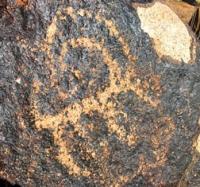You are here
Petroglyphs of Chiygen-Tash.

Сave drawing of Southern Kyrgyzstan.
“I've known rivers:
I've known rivers ancient as the world and older than the flow of human blood in human veins. My soul has grown deep like the rivers”
Langston Hughes.
Photos of petroglyphs of Kyrgyzstan.
The first site is 1km west of Unkur-Tash, on a vertical rock surface facing south. On an area of 1 х 1.1m, six outlined goats are preserved, they were made by pecking (2mm to 3mm deep) and painted. The second group of drawings is located under an overhang 200m west of the first.
It includes several poorly preserved goats and a horizontal line. Repertoire. Unku-Tash drawings mainly include repetitive series of humans (archers-hunters, riders) and animals (mountain goats, horses, camels, deer, and dogs).
The outline drawings were made using simple lines, and only few of them are more exquisite and realistic. Superimposed drawings are rare, but in many cases, traces of repeated refreshing of drawings with paint are noticeable.
Possibly some drawings were refreshed in our days, since there are modern Cyrillic inscriptions with the same shade of paint as some of the paintings. Some parts of individual outlined figures are not covered with paint, possibly due to the refreshing and changing of initial drawings.
Thus, certain details added by pecking to the back of a horse are characteristic of a double-humped camel. As a rule, the drawings are no larger than 10 х 20cm. The drawings were pecked and abraded with a depth of 1 – 3mm and line thickness of 6 - 7mm to 2.5cm.
Combined techniques were often applied. Sketches of some drawings were apparently made by abrading. Most Unkur-Tash and Chiygen-Tash petroglyphs supposedly date to the Middle Ages. Their repertoire is widely represented throughout Central Asia, their technique is more characteristic of medieval petroglyphs. In addition, certain figures apparently date to a more ancient period.
Realistically drawn mountain goats and deer with two vertical antlers and exterior offshoots may date to the Usun period of the Early Iron Age. Some schematic drawings made using lines and paint may date to the Late Middle Ages and New Times.
In general, the site may be interpreted as an ancient sanctuary, probably created in the Early Iron Age, but the tradition of using it and creating drawings was preserved in later periods. Unkur-Tash and Chiygen-Tash are not included in the State List of Sites and no physical protection is provided.
Their location is owned on a conditional basis by one of the local residents.
According to old residents, this area is still worshipped as a cultic site for the Kyrgyz people of the Bagysh tribe. In recent years, efforts have been made to arrange for tourist visits to these sites
Authority:
«Rock Art in Kyrgyzstan». Bakyt Amanbaeva, Aiday Suleymanova, Chynarbek Zholdoshev.
Photos by
Alexander Petrov.







